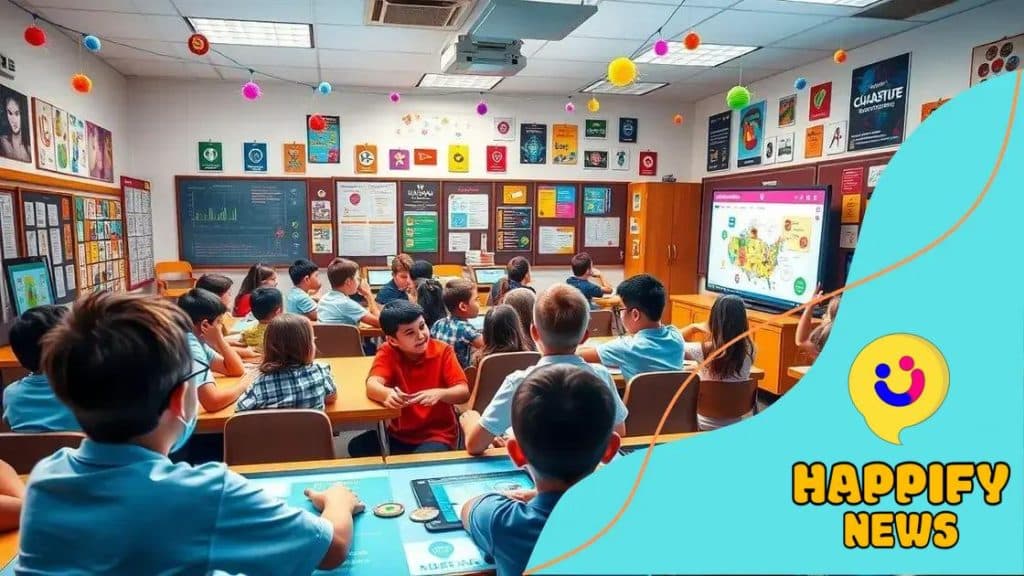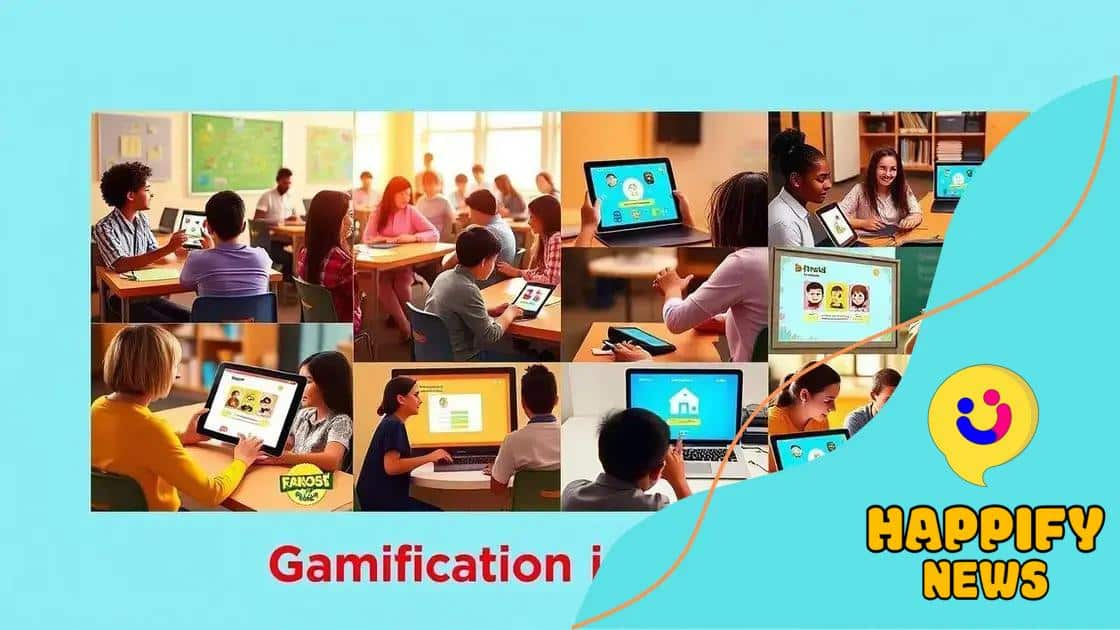Gamification in education: boosting engagement and learning

Anúncios
Gamification in education enhances student engagement and motivation by integrating game elements into learning processes, but it requires careful planning to balance competition and collaboration.
Gamification in education is transforming how students interact and engage with learning material. Have you ever wondered how game principles can make learning more enjoyable and effective? Let’s explore this exciting approach.
Anúncios
Understanding gamification in education
Understanding gamification in education is essential for maximizing student engagement. This innovative approach combines game elements with educational activities, making learning both fun and effective. By incorporating competition, rewards, and challenges, educators can create a more dynamic classroom environment.
What is Gamification?
Gamification is the application of game-design elements in non-game contexts. In education, this means using game-like features to motivate students. Think about points, badges, or leaderboards that can encourage students to perform better.
Key Elements of Gamification
There are several core components that make gamification effective:
Anúncios
- Competition: Encouraging students to compete can boost their motivation.
- Rewards: Offering rewards for achievements can incentivize progress.
- Challenges: Presenting challenges can keep students engaged and invested.
- Feedback: Providing immediate feedback helps students understand their progress.
When these elements are integrated into lessons, they encourage active participation. For instance, a math teacher might turn a standard lesson into a competition, where students earn points for correct answers.
By using gamification, teachers can tap into students’ natural desire for play. Students are more likely to delve deeper into their subjects when they find learning enjoyable. Imagine a classroom where students eagerly collaborate on projects, driven by the excitement of earning points and recognition!
Benefits of Gamification in Education
The advantages are clear. Firstly, gamification promotes higher engagement levels. Students who might otherwise disengage become excited to learn. Additionally, it fosters collaboration. Students often work together, sharing strategies and supporting each other as they tackle challenges.
Furthermore, the use of game-like features encourages a growth mindset. Instead of fearing failure, students see challenges as opportunities to learn. Over time, this leads to improved academic performance.
In summary, understanding gamification in education can transform classrooms into vibrant learning spaces. By embracing these concepts, educators can inspire students to reach their full potential while enjoying the learning process.
Benefits of gamification for students
The use of gamification in education brings numerous benefits for students. This engaging approach not only boosts learning but also makes the process enjoyable. When students interact with educational material as if it were a game, their motivation often increases dramatically.
Increased Engagement
One of the main advantages is heightened engagement. Students become more involved in lessons when they see elements like points and levels. They are less likely to drift away from the topic and more likely to contribute actively.
Enhanced Motivation
Gamification significantly enhances motivation. When students know they can earn rewards for their efforts, they often push themselves to perform better. This motivation extends beyond simply passing a test; it encourages a love for learning itself.
- Rewards for achievement, such as badges and certificates
- Leaderboards that showcase top performers
- Feedback systems that keep students informed about their progress
- Friendly competition that fosters a sense of community
Furthermore, gamification promotes a sense of accomplishment. Students feel proud when they achieve their goals, which reinforces their desire to keep learning. This positive reinforcement is crucial for building confidence.
Additionally, gamified learning structures help students develop problem-solving skills. They learn to think critically as they navigate challenges presented in games. This hands-on approach allows them to apply concepts in real-world scenarios, which improves retention.
Collaboration and Social Skills
Another benefit is the improvement of collaboration and social skills. Many gamified learning experiences encourage teamwork. Students often work in groups to tackle challenges, sharing ideas and strategies along the way.
This not only fosters friendships but also prepares students for future collaboration in the professional world. The ability to work well with others is essential in today’s society.
In summary, the benefits of gamification for students are vast. By increasing engagement, motivation, and social skills, gamification creates a richer learning experience. Students not only absorb knowledge but also enjoy the journey.
Successful examples of gamification

There are many successful examples of gamification in education that illustrate its effectiveness. These examples showcase how gamified systems can enhance student learning and make lessons more captivating.
Classroom Examples
One well-known success is Classcraft. This platform turns classroom management into a game where students earn points for positive behaviors. They can create characters and embark on quests, which encourages teamwork and responsibility.
Education Platforms
Another impressive example is Kahoot!. This platform allows teachers to create quizzes that students answer in real-time on their devices. The competitive aspect of earning points and being ranked on leaderboards drives engagement, making learning fun.
- Classcraft: Promotes positive behavior and teamwork.
- Kahoot!: Engages students through interactive quizzes.
- Quizizz: Offers homework challenges where students can learn at their own pace.
- Duolingo: Uses game mechanics to teach languages through rewards and challenges.
These platforms not only make learning enjoyable but also foster a collaborative spirit among students. Through gamification, teachers can introduce fun elements that help students master new concepts.
Real-World Applications
Gamification is also used in real-world applications outside the classroom. For instance, companies like Salesforce use gamified elements in their training programs. Employees earn badges for completing courses, motivating them to improve their skills.
Similarly, some organizations implement leaderboards to track performance and reward top achievers. This creates a friendly competition that drives employees to excel.
These successful examples of gamification emphasize how powerful this approach can be in various learning environments, encouraging not only knowledge retention but also personal growth and social interaction.
Implementing gamification in the classroom
Implementing gamification in the classroom can transform traditional learning into an exciting experience. Educators can use various techniques to make lessons more interactive and engaging for students.
Start with Clear Objectives
Before introducing game elements, it’s important to set clear learning objectives. Teachers need to define what they want students to achieve through gamification. This helps in selecting the right tools and strategies.
Utilize Game Elements
Incorporate elements like points, levels, and rewards into lessons. For instance, teachers can give points for participation or progress in assignments. Students can track their points on a leaderboard, which adds a competitive edge.
- Points for completing tasks and activities
- Badges for achievements, like mastering a concept
- Levels that students can advance through as they learn
- Challenges that encourage problem-solving skills
These game features not only make learning more enjoyable but also motivate students to strive for success. When students see visible progress, they tend to engage more in the learning process.
Foster Collaboration
Gamification can also promote collaboration among students. Group activities like team challenges encourage students to work together. This builds teamwork skills and makes learning a communal effort.
Additionally, teachers can leverage technology tools like educational apps and platforms that support gamified learning. These tools often offer features that enhance collaboration and make tracking progress easier for both teachers and students.
Incorporate Feedback
Feedback is crucial in a gamified classroom. Regularly provide students with feedback on their performance. This not only helps them understand their strengths and areas for improvement but also keeps them motivated. Immediate feedback can spark interest and push students to continue working towards their goals.
By implementing these practices, teachers can create a dynamic learning environment where gamification thrives. Students remain engaged, work collaboratively, and continually develop their skills while enjoying the process.
Challenges and considerations in gamification
While there are many benefits to using gamification in education, there are also specific challenges and considerations to keep in mind. Understanding these issues is key to successfully implementing gamified elements in the classroom.
Balancing Competition and Collaboration
One challenge is balancing competition and collaboration among students. While some students thrive in a competitive environment, others may feel anxious or discouraged. It’s essential to create a classroom culture where teamwork is encouraged. Incorporating team-based challenges can help mitigate competitiveness and promote shared success.
Time and Resources
Implementing gamification requires time and resources. Teachers must invest initial effort into designing and setting up gamified systems. This process can be time-consuming, especially when selecting the right tools and platforms. Additionally, schools may face budget constraints that limit the ability to purchase necessary technology and resources.
- Identify available resources and tools before starting.
- Set realistic timeframes for implementation.
- Consider using free or low-cost gamification platforms.
- Trial and error may be necessary to find what works best.
Finding the right balance between engaging students and managing these logistical challenges is crucial for successful gamification.
Technology Dependence
An increased reliance on technology is another concern. While digital tools enhance gamification, they can also lead to issues if access is limited. Not every student may have the same access to technology at home or during school hours. This can create inequalities in learning opportunities. Thus, teachers need to consider alternative ways to engage students who may not have regular access to devices.
Finally, teachers should ensure that the gamification strategies align with educational goals. It’s important that the games don’t overshadow the learning objectives. Programs should enhance comprehension and retention of material rather than distract from it. A clear focus on what students should learn is essential for effective implementation of gamification.
FAQ – Questions about Gamification in Education
What is gamification in education?
Gamification in education refers to integrating game elements into learning to enhance student engagement and motivation.
What are the benefits of using gamification?
The benefits include increased student engagement, improved motivation, and enhanced collaboration among peers.
What challenges might arise when implementing gamification?
Challenges can include balancing competition and collaboration, managing time and resources, and ensuring equitable access to technology.
How can teachers effectively implement gamification in their classrooms?
Teachers can start by setting clear objectives, incorporating game elements, fostering collaboration, and providing regular feedback to students.






